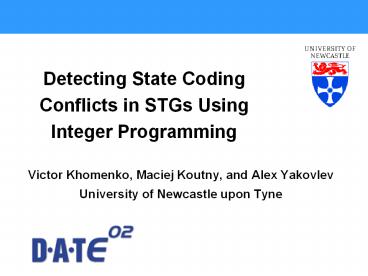Detecting State Coding Conflicts in STGs Using Integer Programming - PowerPoint PPT Presentation
Title:
Detecting State Coding Conflicts in STGs Using Integer Programming
Description:
Detecting State Coding. Conflicts in STGs Using Integer ... No page swapping! 17. SG Unf. Checking consistency. Checking semi-modularity. Deadlock detection ... – PowerPoint PPT presentation
Number of Views:61
Avg rating:3.0/5.0
Title: Detecting State Coding Conflicts in STGs Using Integer Programming
1
Detecting State Coding Conflicts in STGs Using
Integer Programming
- Victor Khomenko, Maciej Koutny, and Alex Yakovlev
- University of Newcastle upon Tyne
2
Talk Outline
- Introduction
- Asynchronous circuits (AC)
- Algorithmic problems in AC synthesis
- State graphs vs. net unfoldings
- Translating a CSC problem into an IP problem
- Solving the IP problem
- Analysis of the algorithm
- Experimental results
- Future work
3
Asynchronous Circuits
- AC circuits without clocks
- Low power consumption
- Average-case rather than worst-case performance
- Low electro-magnetic emission
- No problems with the clock skew
- Hard to synthesize
- The theory is not sufficiently developed
- Limited tool support
4
Example VME Bus Controller
5
Problems in AC Synthesis
- Checking consistency
- Checking semi-modularity
- Deadlock detection
- Checking CSC
- Enforcing CSC
- Deriving equations
- Technology mapping
6
Example CSC Conflict
7
State Graphs vs. Unfoldings
- State Graphs
- Relatively easy theory
- Many efficient algorithms
- Not visual
- State space explosion problem
8
State Graphs vs. Unfoldings
- Unfoldings
- Alleviate the state space explosion problem
- More visual than state graphs
- Proven efficient for model checking
- Quite complicated theory
- Not sufficiently investigated
- Relatively few algorithms
9
State Graphs vs. Unfoldings
- SG Unf
- Checking consistency ? ?
- Checking semi-modularity ? ?
- Deadlock detection ? ?
- Checking CSC ? ?
- Enforcing CSC ? ?
- Deriving equations ? ?
- Technology mapping ? ?
10
Translation Into an IP Problem
11
Translation Into an IP Problem
Code(x)Code(x)
M0 I x ? 0 M0 I x ? 0
12
Solving the IP Problem
1
13
Solving the IP Problem
0
14
Solving the IP Problem
15
Analysis of the Algorithm
- Moderate memory requirements O(E)
- The algorithm can be stopped after the first
solution is found - Usual IP solvers heuristics can be applied
- The algorithm can easily be generalized to check
other coding properties, e.g. USC and normalcy - Optimization is possible for certain net
subclasses, e.g. unique-choice nets
16
Experimental Results
- Unfoldings are usually not much bigger than the
original STGs, i.e. unfoldings are well-suited
for synthesis - If there is a CSC conflict the algorithm finds it
almost instantly - If there is no CSC conflict the algorithm proves
this in a reasonable time, often faster than
BDD-based algorithms - No page swapping!
17
Future Work
- SG Unf
- Checking consistency ? ?
- Checking semi-modularity ? ?
- Deadlock detection ? ?
- Checking CSC ? ?
- Enforcing CSC ? ?
- Deriving equations ? ?
- Technology mapping ? ?































